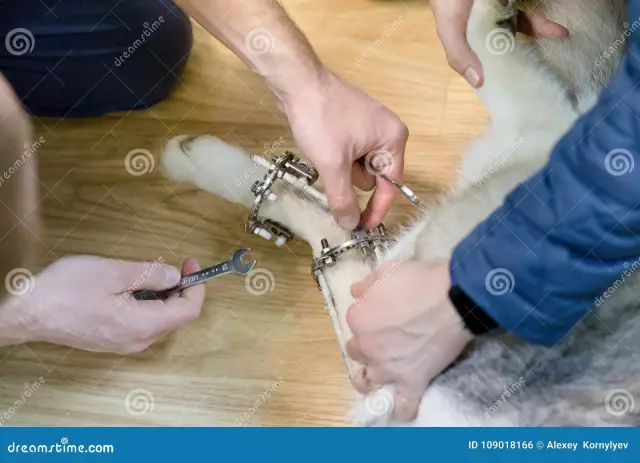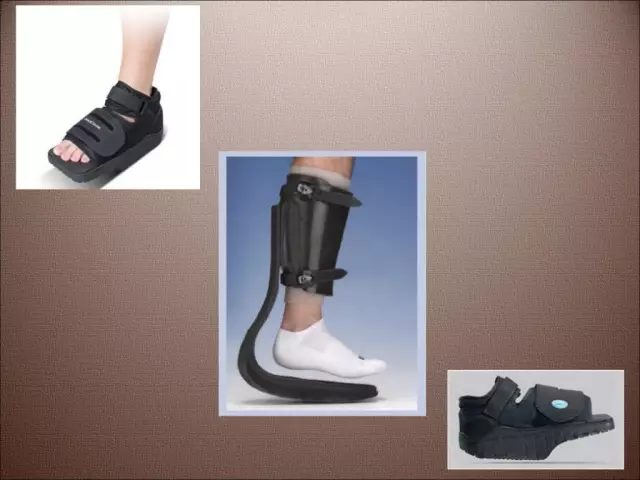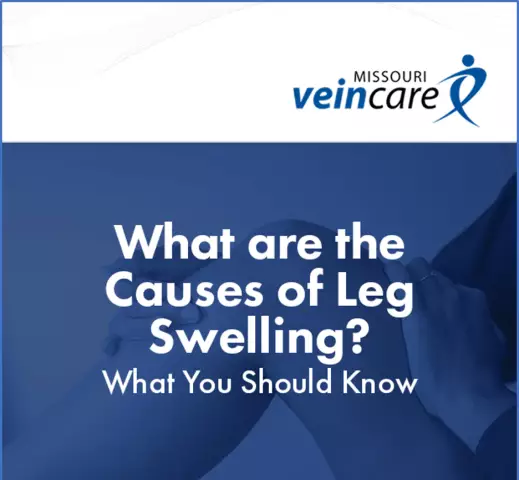- Author Rachel Wainwright [email protected].
- Public 2024-01-15 19:51.
- Last modified 2025-11-02 20:14.
Leg contusion: symptoms, treatment, possible complications
The content of the article:
-
Symptoms
- Hip joint
- Hip
- Knee-joint
- Shin
- Ankle and foot
-
Treatment
What to do at home with a bruised leg
- Forecast and possible consequences
- Video
A leg contusion occurs as a result of traumatic injury to soft tissues during falls or direct impacts. When you receive it, you should seek help from the emergency room, where a specialist will make an accurate diagnosis and recommend how to treat it most effectively.

To determine the nature of the injury and prescribe treatment, you must consult a doctor
In most cases, the prognosis for bruises of varying severity is favorable if the victim is provided with timely medical care. The development of hypertensive syndrome is extremely rare.
Symptoms
Injuries in various parts of the lower extremities are distinguished by the severity of the manifestations and the accompanying complications.
Hip joint
Damage in this area is usually caused by a fall on the side or a direct impact. Most often, the affected area is the greater trochanter, less often the branches of the pubic bone, the iliac crest and the sciatic tubercle.

Injuries to the hip joint can lead to limited movement
Due to the blow, there is a dull pain, local swelling and restriction of movement up to lameness. At the site of the impact, hemorrhages and hematomas can be observed.
Of particular importance in diagnosis is the differentiation of bruises from fractures of the hip. The diagnosis of contusion is confirmed if absent:
- shortening and forced position of the limb;
- stuck heel symptom;
- sharp pain when feeling and tapping bone structures and the greater trochanter;
- changes in bone structures on computed tomography.
Hip
In the overwhelming majority of cases, these injuries are caused by a direct hit with a heavy object. Due to the presence of large massive muscles with a good blood supply, thigh bruises are accompanied by the formation of hematomas in the thickness of the muscles or under the skin, extensive hemorrhages and significant swelling.
During the diagnosis, X-rays may be required to exclude a fracture and magnetic resonance imaging (MRI) if a hematoma is suspected. The photo of the study is evaluated by the doctor along with other test results.
Knee-joint
Typically, such injuries are caused by a fall or direct impact due to sports or domestic injuries. The victim has difficulty in limb movement, hemarthrosis, increased pain on palpation, swelling, hemorrhages on the anterior or anterolateral surface of the joint, in some cases - lameness.

Knee injury often occurs when falling
In the course of diagnosis, contusion is differentiated from intra-articular fractures, meniscus ruptures and ligament injuries. If it is not possible to accurately diagnose by external examination and palpation, they give a referral for arthroscopy, radiography or MRI of the knee joint.
Shin
The bruise usually occurs as a result of a direct impact. The injured lower leg begins to swell greatly. Hemorrhages on the skin, limitation of movement, and in some cases lameness are noted. As in the hip, hematomas can occur in this area, but of a smaller size. In severe injuries, detachment of soft tissues occurs.
Ankle and foot
Injuries in this area can occur when heavy objects are dropped or during sports. Often they are accompanied by high-intensity pain syndrome, swelling, blue discoloration of soft tissues, as well as bruising on the skin.

Ankle and foot injuries are usually associated with severe pain.
Movement in such cases is difficult, since during a step the main load falls on the distal part of the foot. During the diagnosis, they check whether the ligaments are damaged and whether there is a fracture.
Treatment
In case of bruises, conservative treatment is used. It is better for the victim to remain in the supine position with a straightened injured limb. With severe pain, analgesics are prescribed; it is recommended to apply cold compresses to the site of the injury, which should subsequently be replaced with warm ones.

Cold should be applied to the site of injury after injury.
After 2-3 days, the patient is referred for ultra-high-frequency therapy. On average, rehabilitation lasts 2-3 weeks, but in severe cases, its duration can be increased to 2 months or more.
If a severe bruise of the leg is accompanied by complications, additional treatment methods are used, namely:
| Localization of injury | Therapy |
| Foot, ankle | If a subungual hematoma is found, an autopsy is performed |
| Shin | Large and old non-absorbable hematomas are indications for autopsy |
| Knee-joint | If hemarthrosis is detected, a puncture of the knee joint is performed. In severe cases, it is recommended to cover the knee with a plaster cast |
| Hip | For large hematomas, opening, removing clots, draining the cavity and applying a pressure bandage to the leg is necessary. If subfascial hypertensive syndrome is suspected, the pressure in the fascial beds is measured. The indication for opening the fascia is an increase in pressure up to 30 mm or more. rt. Art. |
| Hip joint | If small detachments are found, puncture is performed, after which a pressure bandage is applied to the affected area. Large detachments require more serious intervention - clots and blood are removed through a small incision, and the cavity is drained with a rubber graduate or half-tube |
What to do at home with a bruised leg
The very first thing that the victim should do after the impact is to take a horizontal position, and put the injured limb on a small elevation. Thus, blood flow to the affected area is reduced, and the likelihood of hematoma and swelling decreases.

The injured leg should be placed on a slight elevation
On the affected area, especially if you suspect a dislocation, it is best to apply a tight bandage that ensures full blood circulation. If there are abrasions or scratches, they should be treated with disinfectant solutions.
In case of severe pain, it is better to seek medical help from a traumatologist, as this may indicate a bone fracture.
Forecast and possible consequences
Due to the destruction of nerve endings and soft tissues in severe trauma, dystrophic changes, trophic disorders, aseptic inflammation and subsequent scarring can be detected in the long term.
After severe bruises of the thigh or lower leg, it is possible to develop ossifying myositis and muscle fibrosis. To prevent these complications, it is recommended:
- timely use of absorbable medicines;
- earlier start of movement;
- compliance with the regimen prescribed by the traumatologist.
Video
We offer for viewing a video on the topic of the article.

Anna Kozlova Medical journalist About the author
Education: Rostov State Medical University, specialty "General Medicine".
Found a mistake in the text? Select it and press Ctrl + Enter.






